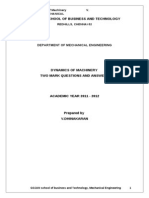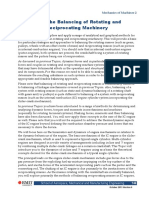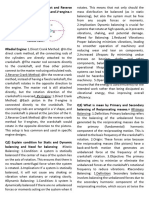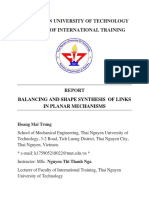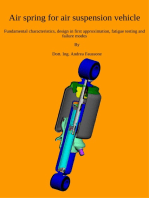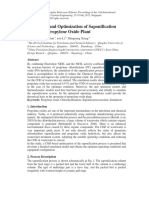Model Ques
Uploaded by
Kannan KModel Ques
Uploaded by
Kannan KPART A
1. Define Inertia Torque and Inertia Force.
The Inertia Force is an imaginary force, which when acts upon a rigid body, brings it in
an equilibrium position.
Inertia force = - Accelerating force = - ma
The Inertia Torque is an imaginary torque, which when applied upon the rigid body,
brings it in equilibrium position. It is equal to the accelerating couple in magnitude by
opposite in direction.
Inertia Torque = - Externally applied torque = - ta
2. What is the purpose of flywheel in an Engine?
The function of a flywheel is to reduce the fluctuations of speed caused by the fluctuation
of the engine turning moment during each cycle of operation.
3. Define D’Alembert’s Principle
D‟Alembert‟s principle states that the inertia forces and torques, and the external
forces and torques acting on a body together result in statical equilibrium.
In other words, the vector sum of all external forces acting upon a system of rigid
bodies is zero. The vector sum of all external moments and inertia torques acting
upon a system of rigid bodies is also separately zero.
4. What is Piston effort?
Piston effort is defined as the net or effective force applied on the piston, along the line of
stroke. It is also known as effective driving force (or) net load on the gudgeon pin.
5. Define Crank effort and Crank Pin effort
Crank effort: It is the net effort (force) applied at the crank pin perpendicular to the crank,
which gives the required turning moment on the crank shaft.
Mail: mechprojects24@gmail.com, Facebook : https://www.facebook.com/MechanicalProjects2476/, Twitter : @mechaero247,
The component of force acting along the connecting rod (FQ) perpendicular to the crank is
known as Crank – Pin effort.
6. List the uses of Turning Moment Diagrams.
The area under Turning Moment Diagram gives work done per cycle.
The work done per cycle when divided by the crank angle per cycle gives the mean
torque Tm.
The mean torque Tm multiplied by the angular velocity of the crank gives the power
consumed by the machine or developed by an engine.
The area of the TMD above the mean torque line represents the excess energy that
may be stored by the flywheel, which helps to design the dimensions and mass of
the flywheel.
7. Distinguish between Radial cam and Cylindrical Cam
Mail: mechprojects24@gmail.com, Facebook : https://www.facebook.com/MechanicalProjects2476/, Twitter : @mechaero247,
8. Why Balancing is necessary?
If the moving part of a machine are not balanced completely then the inertia forces are set
up which may cause excessive noise, vibration, wear and tear of the system. So balancing
of machine is necessary.
Mail: mechprojects24@gmail.com, Facebook : https://www.facebook.com/MechanicalProjects2476/, Twitter : @mechaero247,
9. When is a system said to be completely balanced.
The resultant centrifugal force must be zero and
The resultant couple must be zero.
10. What is meant by balancing of rotating masses?
The process of providing the second mass in order to counteract the effect of the centrifugal
force of the unbalanced first mass is called balancing of rotating masses.
11. What is the hammer blow in Engines with reciprocating masses?
It is defined as the maximum magnitude of the unbalanced force along the perpendicular
to the line of stroke.
It is the result of a compromise when a locomotive's wheels are unbalanced to off-set
horizontal reciprocating masses, such as connecting rods and pistons, to improve the ride.
The hammer blow may cause damage to the locomotive and track if the wheel/rail force is
high enough.
12. Differentiate between Static and Dynamic Balancing.
Static Balancing
The net dynamic force acting on the shaft is equal to zero. This requires that the line of
action of three centrifugal forces must be the same. This is the condition for static
balancing.
Dynamic Balancing
The net couple due to the dynamic forces acting on the shaft is equal to zero, provides the
condition for dynamic balancing.
13. What is partial balancing? Why complete balancing of reciprocating masses is not possible
in a single cylinder engine?
Balancing of reciprocating masses is done by introducing the balancing mass opposite to
the crank. The vertical component of the dynamic force of this balancing mass gives rise
to “Hammer blow”. In order to reduce the Hammer Blow, a part of the reciprocating mass
is balanced. Hence complete balancing is not possible in reciprocating engines.
Mail: mechprojects24@gmail.com, Facebook : https://www.facebook.com/MechanicalProjects2476/, Twitter : @mechaero247,
14. A Flywheel has an unbalanced mass of 0.15 kg at a radius of 0.4 m from the axis of rotation.
Calculate the unbalanced force if the shaft rotates at 200 rpm.
Given:
m = 0.15 kg, r = 0.4 m
Solution:
Unbalanced force = m.r = 0.15 x 0.4 = 0.06 kg-m.
15. Name the efforts caused by the unbalanced primary force acting along the line of stroke
due to partial balancing of Locomotives.
Mail: mechprojects24@gmail.com, Facebook : https://www.facebook.com/MechanicalProjects2476/, Twitter : @mechaero247,
PART B 8x1=8
1. Derive the equation of forces on the reciprocating parts of an engine.
Mail: mechprojects24@gmail.com, Facebook : https://www.facebook.com/MechanicalProjects2476/, Twitter : @mechaero247,
Mail: mechprojects24@gmail.com, Facebook : https://www.facebook.com/MechanicalProjects2476/, Twitter : @mechaero247,
Mail: mechprojects24@gmail.com, Facebook : https://www.facebook.com/MechanicalProjects2476/, Twitter : @mechaero247,
Mail: mechprojects24@gmail.com, Facebook : https://www.facebook.com/MechanicalProjects2476/, Twitter : @mechaero247,
2. How are the different masses rotating in different planes are balanced?
Mail: mechprojects24@gmail.com, Facebook : https://www.facebook.com/MechanicalProjects2476/, Twitter : @mechaero247,
Mail: mechprojects24@gmail.com, Facebook : https://www.facebook.com/MechanicalProjects2476/, Twitter : @mechaero247,
Mail: mechprojects24@gmail.com, Facebook : https://www.facebook.com/MechanicalProjects2476/, Twitter : @mechaero247,
Mail: mechprojects24@gmail.com, Facebook : https://www.facebook.com/MechanicalProjects2476/, Twitter : @mechaero247,
Mail: mechprojects24@gmail.com, Facebook : https://www.facebook.com/MechanicalProjects2476/, Twitter : @mechaero247,
3. What is meant by swaying couple? Deduce the expression for its magnitude and
explain its influence.
Mail: mechprojects24@gmail.com, Facebook : https://www.facebook.com/MechanicalProjects2476/, Twitter : @mechaero247,
Mail: mechprojects24@gmail.com, Facebook : https://www.facebook.com/MechanicalProjects2476/, Twitter : @mechaero247,
PART C
1. An Engine flywheel has a mass of 6.5 ton and the radius of gyration is 2 m if the maximum
and minimum speeds are 120 rpm and 1180 rpm respectively. Find the mean speed of the
flywheel Coefficient of fluctuation Speed and also maximum fluctuation of energy.
Mail: mechprojects24@gmail.com, Facebook : https://www.facebook.com/MechanicalProjects2476/, Twitter : @mechaero247,
Mail: mechprojects24@gmail.com, Facebook : https://www.facebook.com/MechanicalProjects2476/, Twitter : @mechaero247,
2. In a Turning moment diagram the areas above and below the mean torque line taken in
order 4400, 1150, 1300, 4550 mm2 respectively. The scale of the Turning Moment diagram
1 mm = 100 Nm, the crank angle 1 mm = 1⁰. Find the mass of the flywheel required speed
between 297 and 303 rpm, if the radius of gyration is 0.525 m.
Mail: mechprojects24@gmail.com, Facebook : https://www.facebook.com/MechanicalProjects2476/, Twitter : @mechaero247,
m = 1459.89 kg
Mail: mechprojects24@gmail.com, Facebook : https://www.facebook.com/MechanicalProjects2476/, Twitter : @mechaero247,
3. A steam engine runs at 150rpm. Its turning moment diagram have the following datas, Area
measurement in mm2 taken in order of above and below the mean torque line 500, -250,
190, -340, 270, -250. The scale for the turning moment in 1 mm = 500
Nm, Crank angle 1 mm = 5⁰, if the fluctuation speed is not exceeding ± 1.5 % of the
mean. Determine a suitable diagram and cross – section of the rim of the flywheel. Assume
with axial dimension is equal to 1.5 times the radial dimensions. The tensile stress is limited
to 3 MPa and the density of the material of the flywheel is 7500 kg/m3.
Mail: mechprojects24@gmail.com, Facebook : https://www.facebook.com/MechanicalProjects2476/, Twitter : @mechaero247,
Mail: mechprojects24@gmail.com, Facebook : https://www.facebook.com/MechanicalProjects2476/, Twitter : @mechaero247,
Mail: mechprojects24@gmail.com, Facebook : https://www.facebook.com/MechanicalProjects2476/, Twitter : @mechaero247,
A=bxt
= 0.1477 x 0.2215
A = 0.03271 m2
Mail: mechprojects24@gmail.com, Facebook : https://www.facebook.com/MechanicalProjects2476/, Twitter : @mechaero247,
4. The radius of gyration of a flywheel is 1 meter and the fluctuation of speed is not to exceed
1 % of the mean speed of the flywheel. If the mass of the flywheel is 3440 kg and the steam
engine develops 150 kW at 135 rpm, then find, Maximum fluctuation of energy and
Coefficient of fluctuation of energy
5. A rigid rotor has all unbalanced in 1 plane and can be considered to the 3 masses M1
= 5 Kg, M2 = 3 Kg at an angle 165⁰ counter clock wise from M1 and M3 = 8 Kg at angle
85⁰ clockwise from M1, the radius r1 = 20 cm, r2 = 8 cm and r3 = 14 cm. Determine the
balancing mass required at radius of 10 cm. Specify the location of mass with respect to
M1.
6. Four masses M1, M2, M3 and M4 are 200 Kg, 300 Kg, 240 Kg and 260 Kg respectively. The
corresponding radii of rotation are 0.2 m, 0.15 m, 0.25 m and 0.3 m respectively
and the angles between successive masses are 45⁰, 75⁰ and 135⁰. Find the position and
magnitude of the balance mass required, if the radius of rotation is 0.2 m.
Mail: mechprojects24@gmail.com, Facebook : https://www.facebook.com/MechanicalProjects2476/, Twitter : @mechaero247,
Mail: mechprojects24@gmail.com, Facebook : https://www.facebook.com/MechanicalProjects2476/, Twitter : @mechaero247,
7. A shaft carries 4 masses A, B, C and D of magnitude 200 Kg, 300 Kg, 400 Kg and 200 kg
respectively and revolving at radii 80 mm, 70 mm, 60 mm and 80mm in planes measured
from A at 300 mm, 400 mm and 700 mm. The angles between the cranks measured
anticlockwise are A to B 45⁰, B to C 70⁰ and C to D 120⁰. The balancing masses are to be
placed in planes X and Y. The distance between the planes A and X is 100 mm, between
X and Y is 400 mm and between Y and D is 200 mm. If the balancing masses revolve at a
radius of 100 mm, find their magnitudes and angular positions.
Mail: mechprojects24@gmail.com, Facebook : https://www.facebook.com/MechanicalProjects2476/, Twitter : @mechaero247,
Mail: mechprojects24@gmail.com, Facebook : https://www.facebook.com/MechanicalProjects2476/, Twitter : @mechaero247,
Mail: mechprojects24@gmail.com, Facebook : https://www.facebook.com/MechanicalProjects2476/, Twitter : @mechaero247,
Mail: mechprojects24@gmail.com, Facebook : https://www.facebook.com/MechanicalProjects2476/, Twitter : @mechaero247,
Mail: mechprojects24@gmail.com, Facebook : https://www.facebook.com/MechanicalProjects2476/, Twitter : @mechaero247,
You might also like
- Study of a reluctance magnetic gearbox for energy storage system applicationFrom EverandStudy of a reluctance magnetic gearbox for energy storage system application1/5 (1)
- Shell Momentum Balance Flow of Falling FilmNo ratings yetShell Momentum Balance Flow of Falling Film12 pages
- Part A: Crank Effort: It Is The Net Effort (Force) Applied at The Crank Pin Perpendicular To The CrankNo ratings yetPart A: Crank Effort: It Is The Net Effort (Force) Applied at The Crank Pin Perpendicular To The Crank5 pages
- Dynamics of Machinery - 2 Marks - All 5 Units58% (12)Dynamics of Machinery - 2 Marks - All 5 Units13 pages
- 081 - ME8594, ME6505 Dynamics of Machines - Important QuestionsNo ratings yet081 - ME8594, ME6505 Dynamics of Machines - Important Questions20 pages
- Also Refer Last Year Question Papers in Stucor AppNo ratings yetAlso Refer Last Year Question Papers in Stucor App10 pages
- Dynamics of Machinery 2 Marks With AnswersNo ratings yetDynamics of Machinery 2 Marks With Answers18 pages
- Important Short Questions DYNAMICS AND DESIGN OF MACHINERYNo ratings yetImportant Short Questions DYNAMICS AND DESIGN OF MACHINERY32 pages
- 081 - ME8594, ME6505 Dynamics of Machines - 2 MarksNo ratings yet081 - ME8594, ME6505 Dynamics of Machines - 2 Marks20 pages
- ME6505 Dynamics of Machines Part A Q&A Unit-IINo ratings yetME6505 Dynamics of Machines Part A Q&A Unit-II4 pages
- Francis - Engine Dynamics and Structural VibrationNo ratings yetFrancis - Engine Dynamics and Structural Vibration19 pages
- Alstom - Electric Motors Questions and AnswersNo ratings yetAlstom - Electric Motors Questions and Answers56 pages
- 03 POWER TRANSMISSION AND SIZING_REVIEWNo ratings yet03 POWER TRANSMISSION AND SIZING_REVIEW15 pages
- Dynamics of Machinery: Two Mark Questions & AnswersNo ratings yetDynamics of Machinery: Two Mark Questions & Answers14 pages
- Lecture 3.1. Balancing of Rotating Parts(26 Nov)No ratings yetLecture 3.1. Balancing of Rotating Parts(26 Nov)32 pages
- 2 Marks: 1.distinguish Between Space Diagram and Free Body DiagramNo ratings yet2 Marks: 1.distinguish Between Space Diagram and Free Body Diagram4 pages
- Module-2 Balancing of Rotating Masses: Depart of Mechanical Engineering, ATMECE MYSORENo ratings yetModule-2 Balancing of Rotating Masses: Depart of Mechanical Engineering, ATMECE MYSORE26 pages
- Unit 5 Balancing of Reciprocating MassesNo ratings yetUnit 5 Balancing of Reciprocating Masses43 pages
- The Design and Application of A Pneumatic Suspensi PDFNo ratings yetThe Design and Application of A Pneumatic Suspensi PDF7 pages
- Department of Mechanical Engineering Dynamics of MachineryNo ratings yetDepartment of Mechanical Engineering Dynamics of Machinery35 pages
- Classical Approach to Constrained and Unconstrained Molecular DynamicsFrom EverandClassical Approach to Constrained and Unconstrained Molecular DynamicsNo ratings yet
- Influence of System Parameters Using Fuse Protection of Regenerative DC DrivesFrom EverandInfluence of System Parameters Using Fuse Protection of Regenerative DC DrivesNo ratings yet
- A New System of Alternating Current Motors and Transformers and Other EssaysFrom EverandA New System of Alternating Current Motors and Transformers and Other Essays5/5 (1)
- Nano-Emulsions: New Applications and Optimization of Their PreparationNo ratings yetNano-Emulsions: New Applications and Optimization of Their Preparation7 pages
- Lecture 7 Protein Folding: James Chou BCMP201 Spring 2008No ratings yetLecture 7 Protein Folding: James Chou BCMP201 Spring 200840 pages
- Dunham Bush Air Cooled Screw Chiller AFVX B 6SR SeriesNo ratings yetDunham Bush Air Cooled Screw Chiller AFVX B 6SR Series33 pages
- Flash Steam: Are You Venting (Flash) Steam To Atmosphere?: Best PracticesNo ratings yetFlash Steam: Are You Venting (Flash) Steam To Atmosphere?: Best Practices3 pages
- Effect of Torsional and Bending Stress On Machine Parts100% (1)Effect of Torsional and Bending Stress On Machine Parts6 pages
- Science9 - q2 - Mod1 - Mechanical Model of The Atom - v3No ratings yetScience9 - q2 - Mod1 - Mechanical Model of The Atom - v332 pages
- Study Guide Science Grade 4 Earth S WatersNo ratings yetStudy Guide Science Grade 4 Earth S Waters4 pages
- Materials Science in Semiconductor Processing: SciencedirectNo ratings yetMaterials Science in Semiconductor Processing: Sciencedirect10 pages
- Design and Comparison of Sf57 Over Sio2 On Same Structured PCF For Residual Dispersion CompensationNo ratings yetDesign and Comparison of Sf57 Over Sio2 On Same Structured PCF For Residual Dispersion Compensation12 pages
- Study of a reluctance magnetic gearbox for energy storage system applicationFrom EverandStudy of a reluctance magnetic gearbox for energy storage system application
- Part A: Crank Effort: It Is The Net Effort (Force) Applied at The Crank Pin Perpendicular To The CrankPart A: Crank Effort: It Is The Net Effort (Force) Applied at The Crank Pin Perpendicular To The Crank
- 081 - ME8594, ME6505 Dynamics of Machines - Important Questions081 - ME8594, ME6505 Dynamics of Machines - Important Questions
- Also Refer Last Year Question Papers in Stucor AppAlso Refer Last Year Question Papers in Stucor App
- Important Short Questions DYNAMICS AND DESIGN OF MACHINERYImportant Short Questions DYNAMICS AND DESIGN OF MACHINERY
- 081 - ME8594, ME6505 Dynamics of Machines - 2 Marks081 - ME8594, ME6505 Dynamics of Machines - 2 Marks
- Francis - Engine Dynamics and Structural VibrationFrancis - Engine Dynamics and Structural Vibration
- Dynamics of Machinery: Two Mark Questions & AnswersDynamics of Machinery: Two Mark Questions & Answers
- 2 Marks: 1.distinguish Between Space Diagram and Free Body Diagram2 Marks: 1.distinguish Between Space Diagram and Free Body Diagram
- Module-2 Balancing of Rotating Masses: Depart of Mechanical Engineering, ATMECE MYSOREModule-2 Balancing of Rotating Masses: Depart of Mechanical Engineering, ATMECE MYSORE
- The Design and Application of A Pneumatic Suspensi PDFThe Design and Application of A Pneumatic Suspensi PDF
- Department of Mechanical Engineering Dynamics of MachineryDepartment of Mechanical Engineering Dynamics of Machinery
- Worked Examples in Mechanics of Machines using MATLABFrom EverandWorked Examples in Mechanics of Machines using MATLAB
- Wind Power: Turbine Design, Selection, and OptimizationFrom EverandWind Power: Turbine Design, Selection, and Optimization
- Classical Approach to Constrained and Unconstrained Molecular DynamicsFrom EverandClassical Approach to Constrained and Unconstrained Molecular Dynamics
- Influence of System Parameters Using Fuse Protection of Regenerative DC DrivesFrom EverandInfluence of System Parameters Using Fuse Protection of Regenerative DC Drives
- Worked Examples in Mechanics of Machines using MATLABFrom EverandWorked Examples in Mechanics of Machines using MATLAB
- A New System of Alternating Current Motors and Transformers and Other EssaysFrom EverandA New System of Alternating Current Motors and Transformers and Other Essays
- Nano-Emulsions: New Applications and Optimization of Their PreparationNano-Emulsions: New Applications and Optimization of Their Preparation
- Lecture 7 Protein Folding: James Chou BCMP201 Spring 2008Lecture 7 Protein Folding: James Chou BCMP201 Spring 2008
- Dunham Bush Air Cooled Screw Chiller AFVX B 6SR SeriesDunham Bush Air Cooled Screw Chiller AFVX B 6SR Series
- Flash Steam: Are You Venting (Flash) Steam To Atmosphere?: Best PracticesFlash Steam: Are You Venting (Flash) Steam To Atmosphere?: Best Practices
- Effect of Torsional and Bending Stress On Machine PartsEffect of Torsional and Bending Stress On Machine Parts
- Science9 - q2 - Mod1 - Mechanical Model of The Atom - v3Science9 - q2 - Mod1 - Mechanical Model of The Atom - v3
- Materials Science in Semiconductor Processing: SciencedirectMaterials Science in Semiconductor Processing: Sciencedirect
- Design and Comparison of Sf57 Over Sio2 On Same Structured PCF For Residual Dispersion CompensationDesign and Comparison of Sf57 Over Sio2 On Same Structured PCF For Residual Dispersion Compensation






